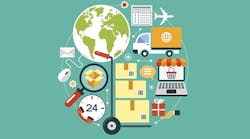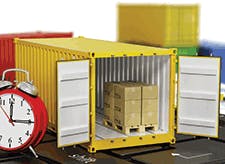Supply chain management (SCM) has become a common concept throughout most businesses, industries and academic institutions. Supply chain technology, however, does not share the same name recognition or understanding. This article will define the concepts of supply chain management and supply chain technology, briefly describe their purpose, and discuss some of the differences relating to these two important concepts.
The Association for Operations Management (APICS) defines supply chain management as: "The design, planning, execution, control and monitoring of supply chain activities with the objective of creating net value, building a competitive infrastructure, leveraging worldwide logistics, synchronizing supply with demand, and measuring performance globally."
Simply put, the supply chain requires managing a network of interconnected businesses involved in the supply of product and services required by the end customers. Supply chain management spans all movement and storage of raw materials, work-in-process inventory, and finished goods from the earliest point of product/service conception to the point it is used by the end customer. The activities included in the supply chain comprise many activities from product development, sourcing, production and logistics, as well as the various information and movement systems needed to coordinate these activities.
Some organizations have even considered what happens when their products are no longer usable as part of the supply chain. For example, a computer manufacturer may consider how the product can be recycled after it is no longer needed.
Supply chain management is both a domestic and an international issue. In our global economy, supply chain management often includes how to work with companies and individuals located in other countries. This may require an understanding of international politics, trade and tariff laws, and quality control standards. It also includes timing of deliveries, including shipping issues and costs.
In a true sense, as Kevin J. Fleming, principal investigator of The National Center for Supply Chain Technology Education (SCTE), suggests, "Supply chain management involves the interplay between high technology and sound business management practices to improve the competitiveness of corporations and the effectiveness of government operations." It is this interplay that requires the use and need for supply chain technology as supply chain technologies enable supply chains.
Supply chain technology includes the various equipment, machinery, hardware and software that provide the ability for organizations to operationalize their supply chains. Technologies included in the supply chain consist of such devices as optical scanners, automated storage and retrieval systems (AS/RS), programmable logic controllers (PLC), conveyor systems, radio frequency identification (RFID), sensors, robotics, database management systems, inventory control systems and local area networks.
These technologies are used in a plethora of industries, including:
- 21st Century warehouses,
- food processing to ensure the food supply is safe and efficiently distributed,
- pharmaceutical product storage and distribution via secure refrigerated warehouses,
- hospital delivery rooms where RFID tags are attached to newborn babies to protect against taking home the wrong child,
- seaports, railroads and transportation hubs to move and track smart containers, and U.S. Department of Defense and other public sector agencies to ensure goods are acquired, moved and distributed efficiently and effectively to manage the movement and storage of large volumes of retail products and consumer goods.
Supply chain technologies are critical to the supply chain and require individuals with specialized training and education to ensure their success. The SCTE refers to these individuals as "supply chain technicians," and defines a supply chain technician as "a person who installs, operates, supports, upgrades, or maintains the software, hardware, automated equipment and systems that support the supply chain."
In summary, one can think of supply chain management as the overarching concept that includes all the activities and processes required to supply an end product or service to the customer. Supply chain technology includes the various technologies that are required by the supply chain (and, therefore, by supply chain management) to ensure that the products and services can flow from the initial starting point to the customer.
Ned D. Young, Ph.D. is co-principal investigator with the National Center for Supply Chain Technology Education (www.supplychainteched.org).




